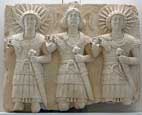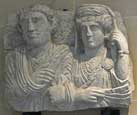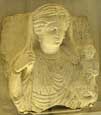
Syria, Bir Wereb, near Palmyra. 1st half of 1st c. CE. Limestone relief, 56 x 72 cm. Rare depiction of the supreme god flanked by gods of sun and moon. Mixture of Parthian-style and Roman-style military garb.
Inv. no. AO 19801. Website

Syria, Palmyra, April 142 CE. Limestone. 74 x 32 cm. Inscription: "In commemoration for the One whose name is blessed. Zabd'ateh, son of Hagagu, son of Bar'ateh "Alayb'al, has made this incense altar for his life, the life of his sons and his brothers in the month of Nisan, year 453."
Inv. no.: AO 28377. Website (no photo yet).

Syria, Palmyra, 176 CE ("in the month of Adar 487"). Limestone. 56 x 52 x 26 cm.
Inv. no.: AO 2200. Website

Syria, Palmyra, 1st half of 2nd c. CE. Limestone. 55 x 47 x 25.5 cm.
Inv. no.: AO 5004. Website (no photo yet).

Syria, Palmyra, end of 2nd c. or 1st quarter of 3rd c. CE. Stone (dolmicrite). 55 x 69 x 22 cm. Inscription: "Zabdibol, son of Salman, Alas! Haggai, daughter of Haddudan, Alas!"
Inv. no.: AO 4449. Website (no photo yet).

Syria, Palmyra, 2nd half of 2nd c. BCE. Limestone.

Syria, Palmyra, 2nd half of 2nd c. BCE. Limestone. 53 x 43 x 21 cm.
Inv. no.: AO 2196. Website

Syria, Palmyra. 2nd half of 2nd c.-1st half of 3rd c. CE. Limestone.
Inv. no.: AO 1556. Website

Syria, Palmyra, 2nd half of 2nd c.-beg. of 3rd c. CE. Limestone, traces of polychrome. 29 x 19 x 14 cm.
Inv. no.: AO 26432. Website (no photo yet).

Syria, Palmyra, 3rd c. CE. Limestone. 54 x 44 x 23 cm. Inscription is a modern addition visually imitating Palmyran inscriptions.
Inv. no. AO 1575. Website

Syria, Palmyra, 3rd c. CE. Limestone. 52 x 58 x 21 cm.
Inv. AO 4147. Website

Syria, Palmyra, 3rd c. (before 272) CE. Limestone. 25 x 14 x 10 cm. Part of a sculptural group on lid of a sarcophagus.
Inv. no.: AO 20124. Website (no photo yet).

Syria, Palmyra, 2nd c.-3rd c. CE. Limestone. 102 x 32 x 28 cm.
Inv. no.: AO 22252. Website (no photo yet).


Syria, Dura Europos (Salhiye). 194 CE. 97 x 211 x 15 cm. Figure of Eros on left was part of a banqueting scene that remained in situ. Palmyrian graffiti were added later.
Inv. no.: AO 17310. Website